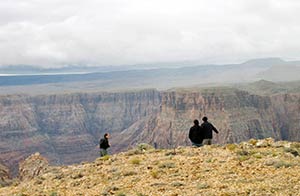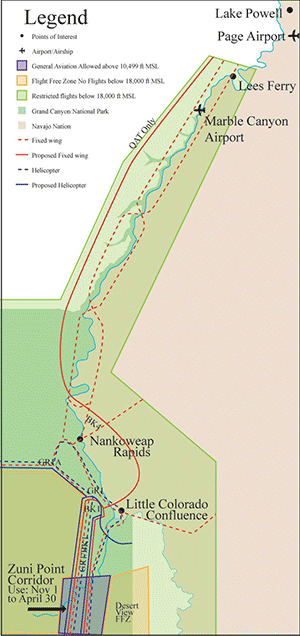Hearing doesn't fly
Gap-Bodaway residents deprived of chance to air their views on overflight issue
By Cindy Yurth
Tséyi' Bureau
GAP-BODAWAY, Ariz., Nov. 7, 2011


TOP: Paul Joly of the Federal Aviation Administration and Navajo Nation Council aides take in the view from the rim of the Little Colorado River gorge. If those who favor development have their way, the site may one day sport a hotel and a tram to the bottom of the canyon. Some residents of Gap-Bodaway Chapter oppose any development in the area, while others want to make sure chapter members reap some benefit from any budding tourist business. (Times photo - Cindy Yurth)
BELOW: This map shows the existing and proposed flight paths over the eastern portion of the Grand Canyon, where the national park abuts the Navajo Nation. (Source: National Park Service)
"I cannot allow people to be verbally abused at this hearing, either inside or outside of this building," said Katherine Benally (Chilchinbeto/Dennehotso/Kayenta).
The hearing was scheduled at the Gap-Bodaway Chapter House after residents of the chapter appealed to the committee to hold a hearing there because it would be the chapter most affected by overflights, and to see the land for themselves.
However, some chapter members became angry when Ivan Gamble, who owns a tour company in LeChee and has been helping Cameron Chapter with tourism development plans, took Benally, two of her aides and Federal Aviation Administration air tour safety specialist Paul Joly on a tour of the area before the meeting, causing Benally to be 40 minutes late.
As she was the only committee member to show up for the hearing, the tour delayed the start of the hearing.
Some members of the Wilson family, who have been opposing flights over their home-site and grazing lease areas unless they are compensated, confronted Gamble at the hearing.
They moved the argument outside when it became apparent they were disrupting the hearing, but Benally put a stop to the hearing nonetheless, before the National Park Service could even finish its presentation on proposed new flight paths that are part of its draft environmental impact statement.
Dolores Wilson Aguirre said the family had been hoping to escort the committee to the proposed flyover area after the meeting, and felt Gamble, who is pro-development, had taken time away from the public meeting to bend Benally's ear in private.
"He (Gamble) doesn't speak for us," Aguirre said. "He doesn't even live here. It seems like he just showed up for his own interest, which is making money."
Gamble said he had deliberately avoided the Wilsons' area and had instead taken the tour through land used by the family of Duane Tsinigine, who represents Gap-Bodaway on the Navajo Nation Council and is in favor of the development.
Aguirre was also upset that the Navajo Nation Council had passed legislation asking the federal government to give the tribe an exemption from the restricted airspace above the Canyon, before they even held the hearing with the locals.
"They're doing it backward," she said.
Benally countered that the Navajo Nation is still formulating a position on overflights and, in case it is not granted an exemption, "we're covering all our bases."
The Wilsons had rallied family members and written at least a dozen comments on the draft EIS, while four months after the comment period ended the Park Service is still waiting for the Navajo Nation to come up with a coherent position it can include in its final EIS.
"We got our comments in on time. We did everything right," Aguirre said, "and yet they're still listening to others. I don't understand why this is still going on."
Arlando S. Teller, a senior planner for the Navajo Nation's Division of Transportation, was representing the Shelly administration at the hearing.
"The president feels there still has been no meaningful government-to-government dialog between the Park Service and the nation," he said.
A coherent Navajo position has been elusive. While neighboring Cameron Chapter has gone on record in support of tapping into the $900 million tourist industry in the Canyon, Gap-Bodaway appears to be split.
Teller, who is developing a plan for improvements to the nation's airports, said the nation is definitely interested in expanding its tourism options. But another tribal employee said he feels it is his duty to oppose any sort of development in the Little Colorado gorge.
"It's the last truly pristine place on Navajo," said Fish and Wildlife Conservation Officer Eddie Benally (no relation to Katherine). "We haven't even documented everything in there. There could be a new plant we don't even know about."
Eddie Benally, who had driven all the way from Gallup hoping to deliver his comments, admitted his opinion is his own and has no official backing. But he feels standing up for the region's wildlife is part of his job.
"Protecting critters, that's what I do," he said.
Meanwhile, the only official position the Navajo Nation has, based on a unanimous Council vote, is that it wants to be exempted altogether from the restricted flight zone above the Canyon. The Park Service will consider that request as it develops its final EIS.
But even that is far from unanimous.
"I don't think the Navajo Nation should get that exemption," declared Willie Long Reed, a member of the Wilson clan. "This is the same government that is accused of misdirecting $32 million in discretionary funds ... Until our tribal government can show us they're capable of managing our assets for the benefit of all the people, they need to stop waving the sovereignty flag."
The proposed new flight paths and rules are in response to a 1987 mandate from Congress to reduce aircraft noise in the Canyon.
(The attached map shows the existing and proposed routes over the eastern part of the canyon.)
The Draft EIS can be reviewed online at: at http://parkplanning.nps.gov/grca

